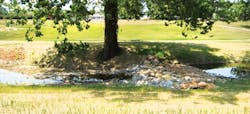About the author: Jeff Moody is Missouri division manager for Williams Creek Consulting. Moody can be reached at [email protected].
Urban storm water management in a fully developed watershed with minimal storm water control measures can be a difficult and daunting task. There are many questions to ask when taking on a project, such as: Where can storm water be managed? How can storm water be managed? Where can funds be located?
The state of Illinois Environmental Protection Agency (IEPA) developed a creative solution to assist communities with the implementation of storm water control measures and the improvement of water quality using sustainable infrastructure. The Illinois Green Infrastructure Grant Program allows communities to apply for grant funding for projects that intend to improve the quality of surface waters. The grants provide design and construction funds for the implementation of sustainable infrastructure.
The city of Alton, Ill., is adjacent to the Mississippi River and is the location of the final Lincoln-Douglas debate, as well as the hometown of Robert Wadlow (the tallest person in history, at 8 ft 11 in.), and has a population of approximately 28,000. The city determined that the grant program would be an opportunity to improve water quality within the local watershed. With the assistance of Heartlands Conservancy, a nonprofit located in nearby Mascoutah, Ill., the city gathered a team to submit an application for a grant from IEPA. Through the request for quotation process, Williams Creek Consulting and Williams Creek Management were selected to design and build the proposed project.
The Project
The watershed that was selected discharges into the east fork of the Wood River, which is a 303(d)-listed impaired river for total suspended solids. The upstream watershed includes a business district that has minimal storm water control measures and expansive amounts of impervious surfaces. On the downstream side of the business district is a golf course owned by the city. The golf course receives the majority of storm water runoff from the business district via a stream.
The watershed, which discharges to the stream, contains approximately 350 acres of commercial development. The commercial development contains little to no storm water control measures to reduce pollutant loads in receiving waters. The existing vertical stream banks were experiencing bed downcutting and bank erosion and also contained a culvert crossing. The banks showed extreme deterioration with the addition of impervious surfaces upstream due to urban expansion in recent years.
Under the grant program, the city could choose a variety of sustainable infrastructure solutions. The course of action utilized a two-stage channel design that would increase the stream’s cross-sectional capacity, thus stabilizing the stream and restoring the riparian corridor through the golf course, as well as improving downstream water quality.
Williams Creek completed a concept design and supporting documentation to submit to IEPA for consideration in December 2010. Approximately six months after the submittal, the project was awarded funding.
Solution & Results
The project involved restoring approximately 1,750 ln ft of stream and 7 acres of riparian corridor. Williams Creek employed a two-stage channel design to create a floodplain, remove the culvert crossing and incorporate multiple grade control structures to act as riffle pool complexes. Additional stone/gravel was placed in the stream channel to create an aquatic habitat for invertebrates. A pedestrian trail was incorporated into the design as a community amenity.
The landscaping incorporated three types of native deep rooting seed mixes. All of the following were utilized within the design: low stature prairie, which included 37 species of grasses and forbs in areas where no inundation should occur; a wet mesic seed mix consisting of 34 species of grasses and forbs in areas where inundation will occur infrequently; and a sedge meadow seed mix consisting of 45 species of grasses, sedges and forbs in areas where inundation will occur on a regular basis. Biodegradable netting straw blankets were installed to assist with moisture retention and erosion control. In addition to seeding, 8,900 native herbaceous plants were installed from the top of the bank to the toe of the stream channel slope to further stabilize the banks. Reforestation of the corridor included 200 1-in. caliper trees with a minimum of six native species and 400 3-gal shrubs with a minimum of six native species, which improved habitats for native species as well as aesthetics.
Williams Creek was involved in the entire design and construction process and therefore was able to make adjustments according to site conditions without incurring additional costs to the owner. The final cost of $680,000 matched the original budget estimate in the grant submittal. The project was completed on schedule. The final design estimated treating approximately 250 million gal of storm water annually and removing 200 tons of suspended solids. Additional benefits included wildlife and aquatic habitat restoration and the creation of a more livable community through improvement of public health and safety, pedestrian connectivity, public beautification and increased educational opportunities.
The project was chosen for a Carl Anderson Conservation Project Engineering Award through the Association of Conservation Engineers. The award recognizes projects that best exhibit the goals and objectives of the organization and that improve and enhance natural resources through restoration and planning.
The project will be a focal point of the area’s future mixed-use development, currently being planned. It will be the first mixed-use development in Alton that will have an overlay district requiring sustainable storm water management techniques
Download: Here


